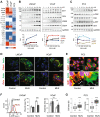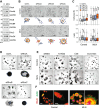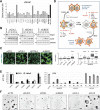Mechanical stress shapes the cancer cell response to neddylation inhibition
- PMID: 35354476
- PMCID: PMC8966269
- DOI: 10.1186/s13046-022-02328-y
Mechanical stress shapes the cancer cell response to neddylation inhibition
Erratum in
-
Correction: Mechanical stress shapes the cancer cell response to neddylation inhibition.J Exp Clin Cancer Res. 2022 May 6;41(1):167. doi: 10.1186/s13046-022-02371-9. J Exp Clin Cancer Res. 2022. PMID: 35513843 Free PMC article. No abstract available.
Abstract
Background: The inhibition of neddylation by the preclinical drug MLN4924 represents a new strategy to combat cancer. However, despite being effective against hematologic malignancies, its success in solid tumors, where cell-cell and cell-ECM interactions play essential roles, remains elusive.
Methods: Here, we studied the effects of MLN4924 on cell growth, migration and invasion in cultured prostate cancer cells and in disease-relevant prostate tumoroids. Using focused protein profiling, drug and RNAi screening, we analyzed cellular pathways activated by neddylation inhibition.
Results: We show that mechanical stress induced by MLN4924 in prostate cancer cells significantly affects the therapeutic outcome. The latter depends on the cell type and involves distinct Rho isoforms. In LNCaP and VCaP cells, the stimulation of RhoA and RhoB by MLN4924 markedly upregulates the level of tight junction proteins at cell-cell contacts, which augments the mechanical strain induced by Rho signaling. This "tight junction stress response" (TJSR) causes the collapse of cell monolayers and a characteristic rupture of cancer spheroids. Notably, TJSR is a major cause of drug-induced apoptosis in these cells. On the other hand, in PC3 cells that underwent partial epithelial-to-mesenchymal transition (EMT), the stimulation of RhoC induces an adverse effect by promoting amoeboid cell scattering and invasion. We identified complementary targets and drugs that allow for the induction of TJSR without stimulating RhoC.
Conclusions: Our finding that MLN4924 acts as a mechanotherapeutic opens new ways to improve the efficacy of neddylation inhibition as an anticancer approach.
Keywords: MLN4924; Mechanical stress; Metastasis; Prostate cancer; Rho GTPases; Tight junctions.
© 2022. The Author(s).
Conflict of interest statement
The authors declare that they have no competing interests.
Figures






References
-
- Eisenhauer EA, Therasse P, Bogaerts J, Schwartz LH, Sargent D, Ford R, et al. New response evaluation criteria in solid tumours: Revised RECIST guideline (version 1.1) Eur J Cancer. 2009;45(2):228–47. - PubMed
-
- Soucy TA, Smith PG, Milhollen MA, Berger AJ, Gavin JM, Adhikari S, et al. An inhibitor of NEDD8-activating enzyme as a new approach to treat cancer. Nature. 2009;458(7239):732–736. - PubMed
MeSH terms
Substances
Grants and funding
LinkOut - more resources
Full Text Sources
Medical

